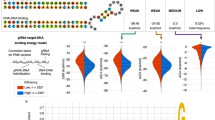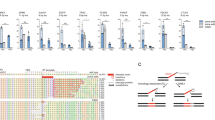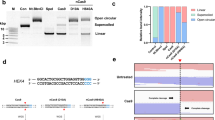Abstract
Methods for in vitro DNA cleavage and molecular cloning remain unable to precisely cleave DNA directly adjacent to bases of interest. Restriction enzymes (REs) must bind specific motifs, whereas wild-type CRISPR–Cas9 or CRISPR–Cas12 nucleases require protospacer adjacent motifs (PAMs). Here we explore the utility of our previously reported near-PAMless SpCas9 variant, named SpRY, to serve as a universal DNA cleavage tool for various cloning applications. By performing SpRY DNA digests (SpRYgests) using more than 130 guide RNAs (gRNAs) sampling a wide diversity of PAMs, we discovered that SpRY is PAMless in vitro and can cleave DNA at practically any sequence, including sites refractory to cleavage with wild-type SpCas9. We illustrate the versatility and effectiveness of SpRYgests to improve the precision of several cloning workflows, including those not possible with REs or canonical CRISPR nucleases. We also optimize a rapid and simple one-pot gRNA synthesis protocol to streamline SpRYgest implementation. Together, SpRYgests can improve various DNA engineering applications that benefit from precise DNA breaks.
This is a preview of subscription content, access via your institution
Access options
Access Nature and 54 other Nature Portfolio journals
Get Nature+, our best-value online-access subscription
$29.99 / 30 days
cancel any time
Subscribe to this journal
Receive 12 print issues and online access
$209.00 per year
only $17.42 per issue
Buy this article
- Purchase on Springer Link
- Instant access to full article PDF
Prices may be subject to local taxes which are calculated during checkout




Similar content being viewed by others
Data availability
Primary datasets are available in Supplementary Table 2. Any other data that support this study are available from the corresponding author upon reasonable request.
Code availability
The script used to determine the SpRYgest rate constants is provided as Supplementary Note 9.
References
Loenen, W. A. M., Dryden, D. T. F., Raleigh, E. A., Wilson, G. G. & Murray, N. E. Highlights of the DNA cutters: a short history of the restriction enzymes. Nucleic Acids Res. 42, 3–19 (2014).
Gibson, D. G. et al. Enzymatic assembly of DNA molecules up to several hundred kilobases. Nat. Methods 6, 343–345 (2009).
Jinek, M. et al. A programmable dual-RNA–guided DNA endonuclease in adaptive bacterial immunity. Science 337, 816–821 (2012).
Collias, D. & Beisel, C. L. CRISPR technologies and the search for the PAM-free nuclease. Nat. Commun. 12, 555 (2021).
Wang, J.-W. et al. CRISPR/Cas9 nuclease cleavage combined with Gibson assembly for seamless cloning. Biotechniques 58, 161–170 (2015).
Jiang, W. et al. Cas9-Assisted Targeting of CHromosome segments CATCH enables one-step targeted cloning of large gene clusters. Nat. Commun. 6, 8101 (2015).
Jiang, W. & Zhu, T. F. Targeted isolation and cloning of 100-kb microbial genomic sequences by Cas9-assisted targeting of chromosome segments. Nat. Protoc. 11, 960–975 (2016).
Li, S.-Y., Zhao, G.-P. & Wang, J. C-Brick: a new standard for assembly of biological parts using Cpf1. ACS Synth. Biol. 5, 1383–1388 (2016).
Jeong, Y. K., Yu, J. & Bae, S. Construction of non-canonical PAM-targeting adenosine base editors by restriction enzyme-free DNA cloning using CRISPR–Cas9. Sci Rep. 9, 4939 (2019).
Shola, D. T. N., Yang, C., Kewaldar, V.-S., Kar, P. & Bustos, V. New additions to the CRISPR toolbox: CRISPR-CLONInG and CRISPR-CLIP for donor construction in genome editing. CRISPR J. 3, 109–122 (2020).
Walton, R. T., Christie, K. A., Whittaker, M. N. & Kleinstiver, B. P. Unconstrained genome targeting with near-PAMless engineered CRISPR–Cas9 variants. Science 368, 290–296 (2020).
Jiang, W., Bikard, D., Cox, D., Zhang, F. & Marraffini, L. A. RNA-guided editing of bacterial genomes using CRISPR–Cas systems. Nat. Biotechnol. 31, 233–239 (2013).
Kleinstiver, B. P. et al. Engineered CRISPR–Cas9 nucleases with altered PAM specificities. Nature 523, 481–485 (2015).
Doench, J. G. et al. Rational design of highly active sgRNAs for CRISPR–Cas9-mediated gene inactivation. Nat. Biotechnol. 32, 1262–1267 (2014).
Chen, T. & Guestrin, C. XGBoost: a scalable tree boosting system. in Proceedings of the 22nd ACM SIGKDD International Conference on Knowledge Discovery and Data Mining 785–794 (Association for Computing Machinery, 2016).
Lundberg, S. M. et al. From local explanations to global understanding with explainable AI for trees. Nat. Mach. Intell. 2, 56–67 (2020).
Thyme, S. B., Akhmetova, L., Montague, T. G., Valen, E. & Schier, A. F. Internal guide RNA interactions interfere with Cas9-mediated cleavage. Nat. Commun. 7, 11750 (2016).
Moreb, E. A. & Lynch, M. D. A meta-analysis of gRNA library screens enables an improved understanding of the impact of gRNA folding and structural stability on CRISPR–Cas9 activity. CRISPR J. 5, 146–154 (2022).
Swarts, D. C. et al. DNA-guided DNA interference by a prokaryotic Argonaute. Nature 507, 258–261 (2014).
Enghiad, B. & Zhao, H. Programmable DNA-guided artificial restriction enzymes. ACS Synth. Biol. 6, 752–757 (2017).
Enghiad, B. et al. PlasmidMaker is a versatile, automated, and high throughput end-to-end platform for plasmid construction. Nat. Commun. 13, 2697 (2022).
Harrington, L. B. et al. A thermostable Cas9 with increased lifetime in human plasma. Nat. Commun. 8, 1424 (2017).
Richter, M. F. et al. Phage-assisted evolution of an adenine base editor with improved Cas domain compatibility and activity. Nat. Biotechnol. 38, 883–891 (2020).
Anzalone, A. V. et al. Search-and-replace genome editing without double-strand breaks or donor DNA. Nature 576, 149–157 (2019).
Xia, Y. et al. T5 exonuclease-dependent assembly offers a low-cost method for efficient cloning and site-directed mutagenesis. Nucleic Acids Res. 47, e15 (2019).
Kleinstiver, B. P. et al. High-fidelity CRISPR–Cas9 nucleases with no detectable genome-wide off-target effects. Nature 529, 490–495 (2016).
Nishimasu, H. et al. Crystal structure of Cas9 in complex with guide RNA and target DNA. Cell 156, 935–949 (2014).
Anders, C., Niewoehner, O., Duerst, A. & Jinek, M. Structural basis of PAM-dependent target DNA recognition by the Cas9 endonuclease. Nature 513, 569–573 (2014).
Chen, Z. & Zhao, H. A highly sensitive selection method for directed evolution of homing endonucleases. Nucleic Acids Res. 33, e154 (2005).
Kleinstiver, B. P., Fernandes, A. D., Gloor, G. B. & Edgell, D. R. A unified genetic, computational and experimental framework identifies functionally relevant residues of the homing endonuclease I-BmoI. Nucleic Acids Res. 38, 2411–2427 (2010).
Zuo, Z. et al. Structural and functional insights into the bona fide catalytic state of Streptococcus pyogenes Cas9 HNH nuclease domain. eLife 8, e46500 (2019).
Hirano, S., Nishimasu, H., Ishitani, R. & Nureki, O. Structural basis for the altered PAM specificities of engineered CRISPR–Cas9. Mol. Cell 61, 886–894 (2016).
Anders, C., Bargsten, K. & Jinek, M. Structural plasticity of PAM recognition by engineered variants of the RNA-guided endonuclease Cas9. Mol. Cell 61, 895–902 (2016).
Kudo, K. et al. In vitro Cas9-assisted editing of modular polyketide synthase genes to produce desired natural product derivatives. Nat. Commun. 11, 4022 (2020).
Enghiad, B. et al. Cas12a-assisted precise targeted cloning using in vivo Cre-lox recombination. Nat. Commun. 12, 1171 (2021).
Moreb, E. A., Hutmacher, M. & Lynch, M. D. CRISPR–Cas ‘non-target’ sites inhibit on-target cutting rates. CRISPR J. 3, 550–561 (2020).
Moreb, E. A. & Lynch, M. D. Genome dependent Cas9/gRNA search time underlies sequence dependent gRNA activity. Nat. Commun. 12, 5034 (2021).
Walton, R. T., Hsu, J. Y., Joung, J. K. & Kleinstiver, B. P. Scalable characterization of the PAM requirements of CRISPR–Cas enzymes using HT-PAMDA. Nat. Protoc. 16, 1511–1547 (2021).
Gurevich, V. V., Pokrovskaya, I. D., Obukhova, T. A. & Zozulya, S. A. Preparative in vitro mRNA synthesis using SP6 and T7 RNA polymerases. Anal. Biochem. 195, 207–213 (1991).
Riesenberg, S., Helmbrecht, N., Kanis, P., Maricic, T. & Pääbo, S. Improved gRNA secondary structures allow editing of target sites resistant to CRISPR–Cas9 cleavage. Nat. Commun. 13, 489 (2022).
Shams, A. et al. Comprehensive deletion landscape of CRISPR–Cas9 identifies minimal RNA-guided DNA-binding modules. Nat. Commun. 12, 5664 (2021).
Gu, W. et al. Depletion of Abundant Sequences by Hybridization (DASH): using Cas9 to remove unwanted high-abundance species in sequencing libraries and molecular counting applications. Genome Biol. 17, 41 (2016).
Gilpatrick, T. et al. Targeted nanopore sequencing with Cas9-guided adapter ligation. Nat. Biotechnol. 38, 433–438 (2020).
Kim, G. B. et al. Rapid generation of somatic mouse mosaics with locus-specific, stably integrated transgenic elements. Cell 179, 251–267 (2019).
Roewer, L. DNA fingerprinting in forensics: past, present, future. Investig. Genet. 4, 22 (2013).
Rohland, N. & Reich, D. Cost-effective, high-throughput DNA sequencing libraries for multiplexed target capture. Genome Res. 22, 939–946 (2012).
Karvelis, T. et al. Rapid characterization of CRISPR–Cas9 protospacer adjacent motif sequence elements. Genome Biol. 16, 253 (2015).
Clement, K. et al. CRISPResso2 provides accurate and rapid genome editing sequence analysis. Nat. Biotechnol. 37, 224–226 (2019).
Acknowledgements
We thank D. R. Edgell for helpful suggestions and S. Mahendraker for assistance developing the web version of SpOT-check. K.A.C. was supported by a Massachusetts General Hospital (MGH) Fund for Medical Discovery Fundamental Research Fellowship Award. B.P.K. acknowledges support from an MGH Executive Committee on Research Howard M. Goodman Fellowship and National Institutes of Health (NIH) grant P01 HL142494. R.T.W. is supported by the National Science Foundation Graduate Research Fellowship Program under grant 1745302. L.P. is partially supported by NIH R35 HG010717.
Author information
Authors and Affiliations
Contributions
K.A.C. and B.P.K. conceived of and designed the study. K.A.C., J.A.G., R.A.S., R.M.D., H.E.S. and L.M. performed experiments. M.M. and G.B.R. expressed and purified SpRY and SpRY-HF1. R.A.S. designed and wrote SpOT-check. R.M.D. and R.T.W. assisted with rate constant determination. J.L. and L.P. performed the predictive modeling. All authors analyzed data. K.A.C. and B.P.K. wrote the manuscript draft and finalized the manuscript, with input from all authors.
Corresponding author
Ethics declarations
Competing interests
K.A.C., R.T.W. and B.P.K are inventors on patents and/or patent applications filed by Mass General Brigham that describe genome engineering technologies, including for the development of SpRY (R.T.W. and B.P.K.). B.P.K. is a consultant for EcoR1 Capital and is an advisor to Acrigen Biosciences, Life Edit Therapeutics and Prime Medicine. L.P. has financial interests in Edilytics and SeQure Dx, Inc. L.P.ʼs interests were reviewed and are managed by Massachusetts General Hospital and Partners HealthCare in accordance with their conflict of interest policies. M.M. and G.B.R. are employees of the Research Department at New England Biolabs (NEB). NEB is a commercial supplier of molecular biology reagents, including some that were used in this work. The remaining authors declare no competing interests.
Peer review
Peer review information
Nature Biotechnology thanks the anonymous reviewers for their contribution to the peer review of this work.
Additional information
Publisher’s note Springer Nature remains neutral with regard to jurisdictional claims in published maps and institutional affiliations.
Supplementary information
Supplementary Information
Table of contents for Supplementary Information, titles of Supplementary Tables 1–7, Supplementary Notes 1–9, Supplementary Figs. 1–18 and Supplementary References
Supplementary Tables
Supplementary Tables 1–7
Supplementary Data 1
PDF file of uncropped gel images
Rights and permissions
Springer Nature or its licensor holds exclusive rights to this article under a publishing agreement with the author(s) or other rightsholder(s); author self-archiving of the accepted manuscript version of this article is solely governed by the terms of such publishing agreement and applicable law.
About this article
Cite this article
Christie, K.A., Guo, J.A., Silverstein, R.A. et al. Precise DNA cleavage using CRISPR-SpRYgests. Nat Biotechnol 41, 409–416 (2023). https://doi.org/10.1038/s41587-022-01492-y
Received:
Accepted:
Published:
Issue Date:
DOI: https://doi.org/10.1038/s41587-022-01492-y



